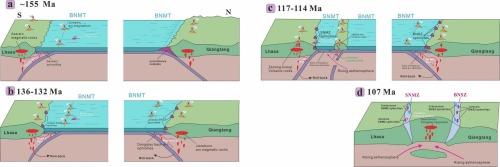Upper Mesozoic tectonic evolution of the Meso-Tethys Ocean: Geochronological and geochemical constraints from central Tibetan Plateau ophiolites and magmatic arc rocks
IF 7.2
1区 地球科学
Q1 GEOSCIENCES, MULTIDISCIPLINARY
引用次数: 0
Abstract
Ophiolites and magmatic arc rocks can provide key constraints on tectonic and geodynamic reconstructions of collisional zones, involving continental assembly and fragmentation through time. With the aim to better define the regional geodynamic evolution of central Tibetan Plateau, in this contribution we report new whole-rock chemical and zircon SHRIMP U-Pb age data from ophiolites and associated magmatic arc rocks of the Meso-Tethys oceanic realm. Lower Cretaceous oceanic crust is indicated by MORB-like pillow basalts (132.9 ± 1.4 Ma) from the Dongqiao ophiolite and sheeted dikes (116.8 ± 1.4 Ma) from the Yunzhug ophiolite. Their geochemical fingerprints are compatible with a DMM-like source, slightly modified by slab-derived metasomatic components, demonstrating a back-arc paleo-tectonic setting of formation. Magmatic arc rocks from the northern and central Lhasa sub-terranes and southern Qiangtang terrane include I-type granitoids from the Asa (155.5 ± 1.0 Ma), Jiarebu Tso (136.1 ± 1.3 Ma), and Dongqiao (107.5 ± 0.9 Ma) areas. These rocks are all compatible with an origin in subduction to post-collisional settings, involving both lower crustal and mantle-derived components. The adakite-like andesites of Wuru Tso (114.1 ± 1.2 Ma) and the andesites of Tangra Yumco (116.1 ± 1.4 Ma) both indicate derivation from subduction-related sources. Specifically, the Wuru Tso andesites originated from the partial melting of an oceanic slab contaminated by enriched mantle, without continental crust contribution, whereas the Tangra Yumco andesites were derived from a subduction-modified mantle source. When framed in the regional scenario, the new temporal and geochemical constraints presented in this study suggest a new Mesozoic geodynamic evolution for the Meso-Tethyan Ocean that includes: (a) co-existence of two retreating subduction systems with opposite polarities (northward and southward) at ∼ 155 Ma; (b) back-arc extension in the upper-plate domains during ∼ 136–132 Ma; (c) slab break-off at ∼ 117–114 Ma; and (d) collision and post-collisional tectonics in the Lhasa-Qiangtang starting at ∼ 107 Ma.

蛇绿岩和岩浆弧岩可以为碰撞带的构造和地球动力学重建提供关键的约束,包括大陆的组装和破碎。东桥蛇绿岩的morb样枕状玄武岩(132.9±1.4 Ma)和云竹蛇绿岩的席状脉(116.8±1.4 Ma)指示下白垩统洋壳。它们的地球化学指纹图谱与类似dmm的物源相一致,并受到板岩交代成分的轻微修改,表明其形成于弧后古构造环境。拉萨次地体北部和中部以及羌塘地体南部的岩浆弧岩中包括来自阿萨(155.5±1.0 Ma)、贾勒布措(136.1±1.3 Ma)和东桥(107.5±0.9 Ma)地区的i型花岗岩类。这些岩石都与俯冲到碰撞后环境的起源相容,包括下地壳和幔源成分。乌如措安山岩(114.1±1.2 Ma)和唐格拉云措安山岩(116.1±1.4 Ma)均显示出与俯冲有关的来源。其中,乌如措安山岩起源于受富集地幔污染的大洋板块的部分熔融作用,没有大陆地壳的贡献,而唐格拉Yumco安山岩则起源于俯冲修饰的地幔源。在区域背景下,本研究提出的新的时间和地球化学约束条件表明,中特提斯洋的新中生代地球动力学演化包括:(a)在~ 155 Ma期间,两个极性相反(南向和北向)的俯冲体系共存;(b)在~ 136 ~ 132 Ma期间,上板块域弧后伸展;(c)在~ 117 ~ 114 Ma时板坯断裂;(d)从~ 107 Ma开始的拉萨-羌塘地区的碰撞和碰撞后构造。
本文章由计算机程序翻译,如有差异,请以英文原文为准。
求助全文
约1分钟内获得全文
求助全文
来源期刊

Gondwana Research
地学-地球科学综合
CiteScore
12.90
自引率
6.60%
发文量
298
审稿时长
65 days
期刊介绍:
Gondwana Research (GR) is an International Journal aimed to promote high quality research publications on all topics related to solid Earth, particularly with reference to the origin and evolution of continents, continental assemblies and their resources. GR is an "all earth science" journal with no restrictions on geological time, terrane or theme and covers a wide spectrum of topics in geosciences such as geology, geomorphology, palaeontology, structure, petrology, geochemistry, stable isotopes, geochronology, economic geology, exploration geology, engineering geology, geophysics, and environmental geology among other themes, and provides an appropriate forum to integrate studies from different disciplines and different terrains. In addition to regular articles and thematic issues, the journal invites high profile state-of-the-art reviews on thrust area topics for its column, ''GR FOCUS''. Focus articles include short biographies and photographs of the authors. Short articles (within ten printed pages) for rapid publication reporting important discoveries or innovative models of global interest will be considered under the category ''GR LETTERS''.
 求助内容:
求助内容: 应助结果提醒方式:
应助结果提醒方式:


